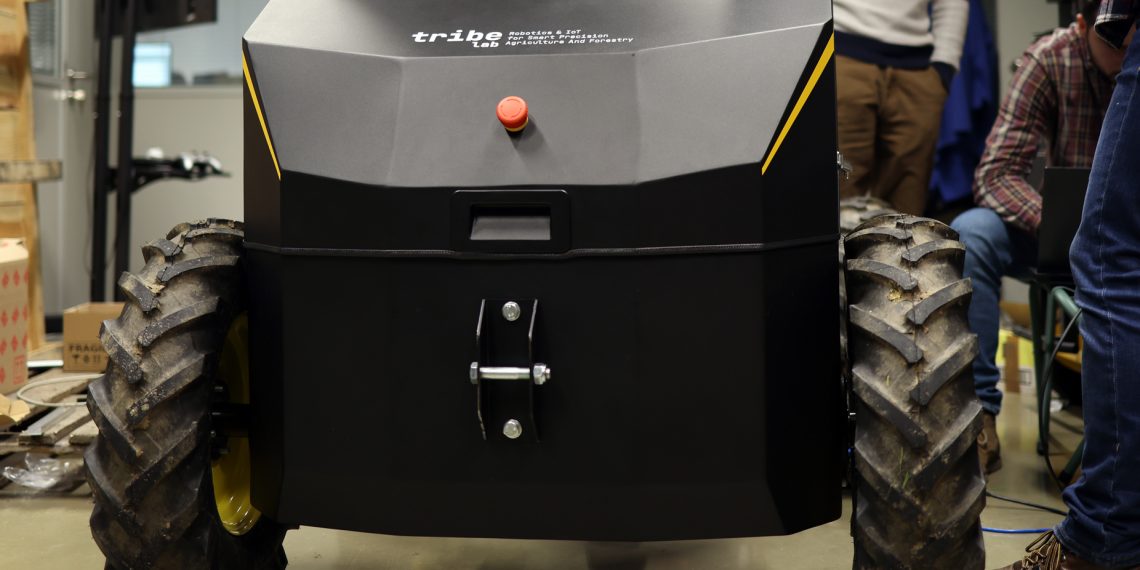Solutions for operating robots in outdoor environments with limited communication infrastructures, and for drawing on irregular objects, have earned honourable mentions for INESC TEC researchers.
A robotic painting system capable of automatically decorating irregular surfaces, and another that enables remote control of ground robots via public mobile networks, were awarded at ROBOT’2025, one of the main robotics events in the Iberian Peninsula.
INESC TEC left the conference, held in November (Porto), with two honourable mentions thanks to two papers addressing pressing challenges in today’s robotic systems, which must be precise, adaptable to difficult environments, and autonomous.
The INESC TEC researchers Manuel Couto, Marina Brilhante, Catarina Rema and Fábio Pacheco were recognised for the paper Industrial Robotic Painting with Dynamic Marker Selection on Nonplanar Objects, and Pedro Rodrigues, André Aguiar, Filipe Neves dos Santos (INESC TEC) and Diogo Mendes (Commop) for A Lightweight Teleoperation Framework for Outdoor Robots over Mobile Networks.
A pottery robot?
To understand the robotic drawing system designed for non-planar objects, we need to go back to March, during the Robotics Open, also in Porto. Everything began with a “challenge” issued to participants by a company, explained Manuel Couto. Researchers had to find a way to address a current challenge in the pottery and ceramics industry: can industrial robots paint pieces?
“During the competition, we were unable to build a 100% functional prototype, but the idea stuck with us,” he said. The INESC TEC team decided to continue working to “prove” that the challenge could be overcome. And they proved it: “It took a lot of work and we thought about giving up, but with everyone’s dedication and effort we managed to reach the result we have today.”
The solution: a complete robotic painting system capable of automatically decorating non-planar surfaces, such as ceramic pieces. Here’s how it works: the system takes as input an image and a 3D model of the surface to be painted, and the user then “adjusts the position and orientation of the surface, the image dimensions, and the characteristics of the painting tool.”
“From there, the system automatically projects the image onto the surface, segments it by colours, calculates the optimal path using four different trajectory-planning algorithms, and converts all the information into the robot’s language, enabling automatic execution of the painting,” added Manuel Couto.
And this is no small feat – it goes far beyond simply making a robotic arm paint. As described in the soon-to-be-published paper, to make it draw, one must draw upon knowledge from fields far beyond robotics: this crosses into computer vision, motion planning, and even “elements of art and aesthetics.” The challenge becomes even greater when the tip of the pen does not meet a flat surface: robotic drawing with a pen “requires continuous contact between the drawing tool and the surface, making the process more sensitive to variations in surface geometry,” the paper states.
Now, the researchers want to scale up, using a larger robotic manipulator. In the coming months, Manuel Couto, Marina Brilhante, Catarina Rema and Fábio Pacheco will also test more colours and complex patterns, experiment with other surfaces and more challenging geometries, and integrate computer-vision systems to ease calibration and increase the system’s flexibility.
Commanding from afar
The team led by Pedro Rodrigues developed a lightweight teleoperation framework designed for ground robots, using mobile networks to control the robot in the field. “This control can be carried out in a more ‘manual’ mode, using a joystick-based controller, or alternatively in a semi-autonomous mode, where it is possible to define trajectories for the robot to follow remotely,” explained the researcher.
The objective: to assess the feasibility of implementing this remote-operation system using public 4G/5G mobile networks. The research focused on the implementation, characterisation and testing of the framework. The researchers were able to test the system in a “real-world context” during ARTEX25, an event organised by the Portuguese Army to trial innovative solutions for the Defence sector. The solution was even tested on the Modular-X robot, developed at INESC TEC.
Mobile-network latency ended up being the main obstacle to system responsiveness. Even so, the paper shows that “the system proved effective, with a maximum response time of 280 milliseconds during field tests.” “These results support the feasibility of using mobile networks to command robots in outdoor environments with limited communication infrastructure,” the researchers concluded.



 News, current topics, curiosities and so much more about INESC TEC and its community!
News, current topics, curiosities and so much more about INESC TEC and its community!